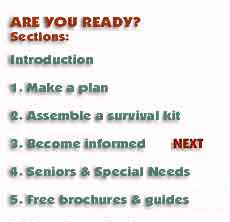|
|
|||
|
Once disaster hits, you won’t have time to shop or search for supplies. But if you’ve gathered supplies in advance, your family can better cope with evacuation or with sheltering in your home. Packing a survival kit should take the same amount of time as packing for a one week vacation. Include a first aid kit and an emergency preparedness manual such as the American Red Cross First Aid book. You can purchase first aid and survival kits from the American Red Cross site at www.redcrossnca.org. Place your survival kit in an easy-to-carry camping backpack, trash container or a duffle bag. A good place to store your kit is in the closet next to the front door. Tape an easy to read list of instructions near the kit for review from time to time. Remember to include cash, a credit card and an extra set of car keys. Then, if disaster hits, you're ready to GRAB your kit and GO! |
|
||
| Essentials
Here are six basics you would most likely need during an evacuation or if you take shelter at home. All of these items can be purchased downstairs at the CVS or the Safeway. You probably have most of the items in your home right now. You may not need everything. Use the list to consider your particular needs. Is this list too long? Yes! This is a generic list of essentials covering all types of disasters. Adjust the list to your personal circumstances. For example, you may find that it it a better idea to include a credit card and not a tent in your kit. You probably have all of the survival kit items in your home right now. All that remains for you to do is to put these aside. Then you will be assured that you have sufficient supplies should an emergency arise. |
|||
|
Water Store water in plastic containers such as soft drink bottles. Avoid using containers that will decompose or break, such as milk cartons or glass bottles. A normally active person needs to drink at least two quarts of water each day. In the summer and during intense physical activity double that amount may be needed. Store 1 gallon of water per person per day (2 quarts for drinking, 2 quarts for food preparation and sanitation. Keep at least a 3-day supply of water for each person in the household. |
 |
||
|
Food Store at least a three-day supply of non-perishable food for each person. Select foods that don't need refrigeration or cooking and little or no water. Select compact, lightweight items.
|
 |
||
|
First Aid Supplies Make a first aid kit for your home and for your car. Kit items:
|
|
||
|
Prescriptions Ask your physician or pharmacist about storing prescription medications.
|
 |
||
|
Clothing and Bedding Include at least one complete change of clothing and footwear.
To avoid breathing infected air, have 2 or 3 layers of cotton t-shirts, hankies or towels to cover your mouth and nose. |
|||
|
Sanitation
|
|
||
|
Tools
|
|||
|
Important Documents Keep records or copies in a waterproof, portable container.
|
|||
|
For Pet
|
|||
Then, if disaster hits, you're ready to GRAB your kit and GO! |



 .
.